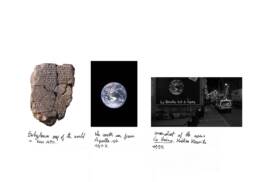In 1969, the ones that had access to it were mesmerized in front of televisions. Thanks to the satellites they were sharing a common memory: the farthest men from Earth, alone on the dark side of the Moon, broadcasted live all around the world. The contemplation of this landmark raised questions, wills, vocations, dreams as well as broke the speculations of living outside Earth. The astronauts had to come back home.
If they failed, President Nixon had a speech prepared, without consideration, this was a try in a permanent adventure exploring who we. are. The act of travelling outside Earth, of contemplating it from space, of reaching the Moon was the major step of a continuous project.
Kennedy reveals this huge ambition through a tiny unnoticed end of sentence in 1962, the decision of going through the difficult path was “to go to the Moon in this decade and do the other things.” Through this political transcendance he led, everybody surpassed. We. are more than ever concerned. He gave a common direction to a common goal.
Thanks to the most advanced technologies deployed for an image, for contemplation, space was within our reach.
Five missions later, ten years after US President discourse, Apollo 17 permits to see the first picture of the whole Earth in 1972. The Blue marble who became the most widely disseminated image in human history was the mainstream picture Steward Brand asked since 1966. Driven by the question “Why haven’t we seen a photograph of the whole Earth yet?”, he collected firms across the US in an attempt to force the NASA. to release a then-rumored picture of the sphere of Earth as seen from space. His spirited campaign ended with the appearance in 1967 of the first color photograph of the whole Earth captured by geostationary weather and communications satellite ATS-3. The image remained underground but the biologist had what he thought was the necessary detonator for the dawn of a common destiny sense and action, in line with the contemporary social wave of renewal. To propel it, he initiates in 1968 in a rudimentary of means The Whole Earth Catalog, an incremental collaborative compilation of information to give “access to tools” and thoughts to live autonomously and harmoniously with Earth. The image made the cover of the first issue of the catalog published from 1968 to 1998; Brand believing in the picture power to “tell us where we’re at” as a “look in a mirror”, concerned that in the race to the moon, neither the US nor the USSR had given attention to turn back their satellites to contemplate the world left behind. The catalog gained popularity with its successive editions which covers used new images of the whole Earth as soon as they were released and became one major support to counterculture of this period. It shared with the spatial program the objective of reconsidering the world. Relying on technology it was at the same time precursor of it.
Steve Jobs gives advices to young graduates in his 2005 speech at Stanford, where he pointed “When I was young, there was an amazing publication called The Whole Earth Catalog, which was one of the bibles of my generation. It was created […] not far from here [the Silicon Valley] in Menlo Park, and he [Brand] brought it to life with his poetic touch. This was in the late 1960s, before personal computers and desktop publishing, so it was all made with typewriters, scissors and Polaroid cameras. It was sort of like Google in paperback form, thirty-five years before Google came along […].”
Tough the young resourceful, becoming one of the major influencers of the technological area, was the leader of his generation shifting. Personal computer science transfigured the ideal of community from the paradigm of space to the one of the information, which is to say time.
In their icons, Superstudio well depicts what the final state this plot twist implies: a state of uniformisation and disconnection conducting to individualisation, denying space. Seeing the global scale means inhabiting the world.
Thanks to its image, Earth seems to become the “absolute architecture” (Aureli 2011). We. had seen ourselves. as the insulars of what people did not represent to themselves: the void, the empty space. “Space is nothing, yet we. have a kind of vague faith in it” (Smithson 1996, 6).
The biggest spatial adventure was set aside by the many. The scale of the world was interpreted in ways of indirect relations in a spatial abstraction, in oblivion. What’s the matter for us. now is space, and void.
“World society has throughout its millions of years on Earth made its judgement upon visible, tangible, sensorially demonstrable criteria. We. may safely say that the world is keeping its eyeing the unimportant visible one percent of the historical transformation while missing the significance of the ninety-nine percent of overall, unseen changes. […] It will reshape the future and save the man for self annihilation […] that man is about to become almost 100 percent successful as an occupant of the universe” (Buckminster 1968).
The pointing of terrestrial globe condition: isolated in a whole, implies awareness and action. “Spaceship Earth” (Orwell 1937) needs its crew. It is a spatial question. In nine chains to the Moon, Fuller though ahead ephemeralization as the possibility, that can be seen apart from technology, of “doing less and less until eventually be able to do everything with nothing” (Buckminster 1938).
In an other famous speech, delivered by Timothy Leary in 1967 at the Human Be-In – a meeting next to Golden Gate Park, San Francisco, addressing more than 30,000 hippies – was declaim what will become the mantra of the counter-culture generation: “Turn on, tune in, drop out” (Leary 1983, 253).
Sending a men to the Moon served both the US interventionist policies and the inclusive counter-culture’s aspirations, before being forsaken. The results of reaching the Moon have been limited because it is not the final what’s important, it is the trip.
“We are in 1985, and barely fifteen years stand between us and a new millennium. For the time being I don’t think the approach of this date arouses any special emotion. However, I’m not here to talk of futurology, but of literature.” Italo Calvino pointed introducing its six Harvard conferences, a legacy as a “memo for the next millenium : 1. Lightness 2. Quickness 3. Exactitude 4. Visibility 5. Multiplicity 6. Consistency” (Calvino 1988).
There we. are.
Space time © Nous
- Aureli, Pier Vittorio, 2011. The possibility of an absolute architecture. Cambridge, MA: Massachusetts Institute of Technology Press.
- Smithson, Robert. 1996. The Collected Writings. Edited by Jack Flam. Berkeley: University of California Press.
- Buckminster Fuller, Richard. 1968. Operating Manual for Spaceship Earth. Edwardsville: Southern Illinois University Press.
- Orwell, Georges, 1937. The Road to Wigan Pier, London: Victor Gollancz. – Made this expression known paraphrasing George, Henry, 1879. Progress and Poverty. New York: Appleton. and popularized by Buckminster Fuller, Richard. 1968. Operating Manual for Spaceship Earth. Edwardsville: Southern Illinois University Press.
- Buckminster Fuller, Richard. 1938. Nine chains to the moon. Philadelphia : Lippincott. – Ttitled in reference of the world population at that time if stood one atop another, could form chains reaching back and forth between Earth and the Moon nine times.
- Leary, Timothy. 1983. Flashbacks: A Personal and Cultural History of an Era. New York: G. P. Putnam’s Sons.
- Calvino, Italo. 1988. Six Memos for the next Millennium. Harvard: Harvard University Press. – It is a collection of five lectures, sort of intellectual and practical legacy, Italo Calvino was about to deliver at Harvard in 1985. He died before writing the sixth conference and giving none of them.
Nous.°
°Nous. meaning both we., us. and ourselves. in French is run by Telmo Escapil-Inchauspé & Guilhem Solère, both born in 1998, the year of the last Whole Earth Catalog publication.
On instragram: @nous.computer

